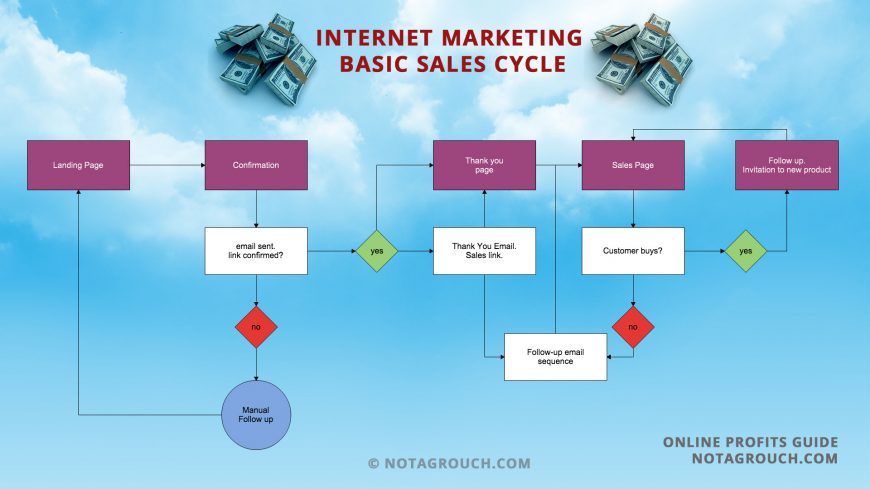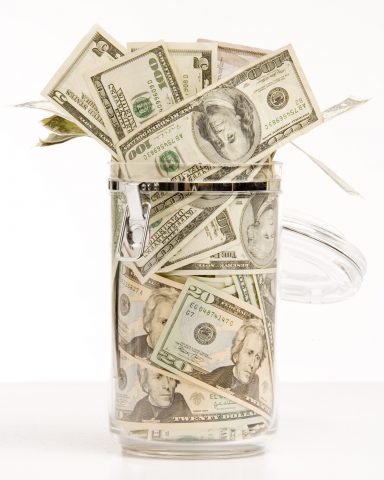The internet marketing basic sales flowchart
I'm a visual kind of a person and I like to see how things work. Since I'm going to be guiding you and teaching how I do what I'm doing, I thought I would create a flowchart, a basic roadmap to explain how landing pages work with your email funnel and the entire sales process.
Take a look at the chart below, and I'll explain it after (click to enlarge).
First things first
In the diagram, each of the purple boxes represents a landing page. Each one is titled differently, but they're all technically landing pages. Some may be sales letters, thank you letters, long-form sales letters, or squeeze pages.

Creating these pages is fairly simple if you use a service or outsource them. I would recommend you take a look at Leadpages as the best service to create these pages for you. They create mobile-friendly, responsive, Facebook-friendly, WordPress compatible, easy, painless, and compatible with Aweber.
First, we will start with the landing page. We are assuming you have traffic going to the landing page. The traffic could be sourced from any type of advertising campaign, social media campaign, word of mouth, or any other method you can muster. We'll cover traffic in another blog post.
Once the visitor gets to a landing page, and the visitor enters the required information, a confirmation page is presented. This page will explain to the visitor to check their email address and click on the confirmation link. This is pretty standard stuff and it relates to that double opt-in process I talked about on my previous post about the email system.
First major step
The visitor now has two options, to confirm the link or to ignore it. For now, let's assume that yes, they click on the confirmation link. This will take the visitor to the Thank you page. The thank-you page may contain the sales letter and offer and most marketers I think would suggest this option.
In the flowchart, I chose to put the sales page as an additional step to illustrate it clearly. Both options are valid, but keep in mind that every time you present an option to click or not to click to continue you risk a percentage of the visitors to not continue. Also note that the Thank you page is presented from the previous email. At this time, another email is also sent. This email tends to mirror the thank you page and sales offer. We'll come back to the email part in a couple of paragraphs.
The sales page needs to present the offer. The offer must be clear and simple to complete; don't overcomplicate the options the visitor has. Present the offer, make it irresistible and make the next step loud and clear. That step is to buy.
To buy or not to buy
We are now at another decision, the customer will decide if they buy or if they save their hard-earned dollars for another day. Let's assume and continue with the positive response flow and assume they purchased your product. Success! this is awesome and you're on your way to earning a living online. At this point, you use another landing page to present them with another offer, another product, perhaps an upgrade to what they purchased. The cycle starts over at that time.
Now let's go back to the thank you email/sales link. At this point, you present the sales offer via email as well as on a website. The email, like the website, provides information about the product. The email serves as a reminder about why they need to buy your product now. They can save the message, reply to you and ask questions, re-read it, forward it, this is why you do both a webpage and an email.
After the first email, you present the follow-up sequence. Opinions differ on what is the right amount of emails in a follow-up sequence, but facts show that constant reminders and relationship-building emails work best as opposed to infrequent ones. Most successful internet marketers will advise you to email your customer every day they haven't purchased your product.
Tie in the email messages to the sales pages

Each email you send gives you an opportunity to expand on the benefits of the product. You can showcase success stories or testimonials. You can present new offers, OTOs (one-time offers), or LTOs (Limited time offers) to encourage them to buy. Then the cycle continues. If you want to be more sophisticated, each email message in your follow-up sequence can send the customer to a customized landing page specific to that offer instead of the same sales page you've used in previous instances.
Now, let's go back to the first choice where the customer didn't confirm the link. For most internet marketers, this step is unorthodox. I add it to my own sales process because I think it is important and we need to account for a few possible scenarios.
The follow up is key
It is important to follow up manually because it gives you a chance to connect with your potential customer. There is also the chance that maybe something went wrong with the email subscription, maybe they didn't get the email, maybe it went to spam. The way to follow up, if you are using aweber, it is easy. Go to your list and look for the unconfirmed email message and manually send the person an email from your email. Introduce yourself, tell them why you're emailing them and help them get through whatever obstacle may be in the way of confirming their request for information via email.
So that's it
There are many ways to follow this model and variations can be endless. The only real way to find out what is the best way is to test each step yourself and see how your product or service performs. You can use a link shortener to easily do A/B testing for example. You can also create several landing pages in just a few minutes in order to test a short sales page vs. a long sales page. It's also easy to move a subscriber or potential customer from one list to another when you're using Leadpages and Aweber; they work together flawlessly.
This process can be applied to almost any type of promotion online. Doesn't matter if you're trying to sell a product, service or just increase the readership of your blog. It even works for a church if you want to increase your congregation. You just have to think out of the box and understand that a product is anything you want someone else to use, and a sale is made anytime you persuade your target customer to buy. Get it?